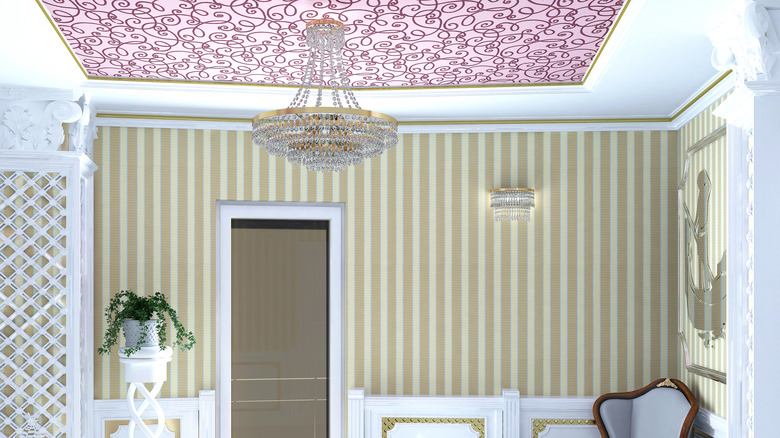Ceilings Are Getting A Bold Makeover With This Stunning Design Trend
One of the most overlooked elements in any space is the one right above your head. Ceilings can be a mixed bag, from stunning wood paneled lofted designs to the low and dismal popcorn-textured surfaces that dominated many homes in the 20th century. Newer trends are pointing toward renewed attention to this space as an element just as important as the walls that support it.
This includes many designers using wallpaper and patterns up top, which can greatly impact the room's overall effect and feel. By using this all-important decorative element to its best advantage, you can achieve a dramatic transformation for limited cost and labor. Adding wallpaper to the ceiling is much less expensive than all four walls if you want to add another visual layer, but don't want the room to feel dominated by pattern. Peel-and-stick wallpaper or murals allow renters to enjoy the benefits of a gloriously wallpapered ceiling.
Where wallpaper ceilings work best
Wallpaper on the ceiling can add visual interest that draws the eye up and makes the room feel more expansive. This effect is one of the reasons that HGTV and Magnolia Network's Joanna Gaines favors this approach for upgrading your ceiling, using it in many remodels and homes she works on. The ceiling becomes a dynamic focal point and a backdrop that brings in other colors and materials that tie it together. This also works for other architectural elements in a room. Sallie Lord of Greyhunt Interiors tells Northern Virginia, "Wallpapering a ceiling in a room that has lots of doors, windows, and built-ins is a great way to visually bring all those disparate elements together, and make the room look cohesive."
This visual impact of wallpaper can make a lower ceiling feel taller, while at the same time, bringing a vaulted ceiling down for a cozier feel. The trick, according to Lord, is mastering scale, proportion, and pattern. A smaller room with a lower ceiling often does best with a smaller pattern that doesn't demand as much attention, with mid-size patterns frequently reading as too busy. The trick is finding the balance. You will want to avoid any pattern with a dedicated direction since you will see it from all angles. Rooms with a defined border, like trim or molding, are often the best choice.
Where wallpaper on the ceiling may not work
Textured or paneled ceilings can often be a poor place for wallpaper, since you may have to do considerable work to smooth the surface before application. Those ubiquitous popcorn ceilings can be especially labor-intensive to remove and may just not be worth it. Rooms that suffer a lot of moisture, like a bathroom or kitchen, can often cause peeling and mold issues, so these rooms may want to be avoided.
While you may save on materials by wallpapering a limited surface, you might want to hire a professional, or at least an extra set of hands, to help you add wallpaper to a ceiling, particularly for larger expanses. Gravity can make this job much harder than the walls. Bubbles and imperfections will be very visible and unable to be hidden quite as well as paper on the walls. For beginning DIYers, try a small space like hallways or entryways before approaching larger jobs.


